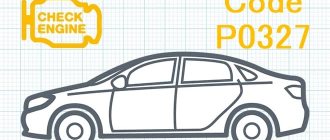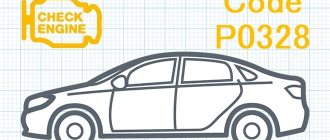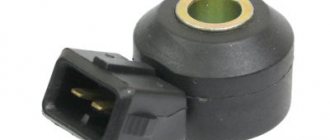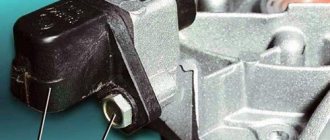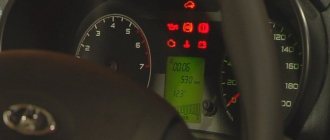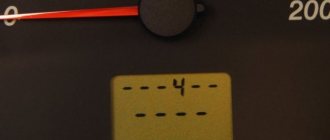Technical description and interpretation of error P0030
This diagnostic trouble code (DTC) is a generic code. The P0030 code is considered a common code because it applies to all makes and models of vehicles. Although the specific repair steps may vary slightly depending on the model.
In cars, heated oxygen sensors are used to determine the oxygen content in the exhaust system before and after the catalytic converters. They use feedback to adjust the fuel system. To maintain an optimal air-fuel mixture ratio of 14.7:1.
Oxygen sensors use a heated circuit to heat the sensor for faster feedback. The oxygen sensor may use three or four wires depending on the vehicle.
Two are typically used for feedback to the powertrain control module (PCM). And the other wires are intended for the heater and powering the heated circuit. Three-wire sensors are usually grounded through the exhaust system. And four-wire ones have a separate ground wire.
Code P0030 refers to the sensor upstream of the Bank 1 catalytic converter, which is located on the #1 cylinder side of the engine. The error means that the problem with the HO₂S sensor heating element has not been resolved. This code is triggered when the sensor takes too long to heat up.
Lada Granta errors P0363 P1304
#1 Rexis
Lada Granta 2012 standard 183 8-valve engine.
I started the “warm” car, it started to stall, became dull when accelerating, didn’t pick up from the bottom, and responded very sluggishly to the gas pedal. I got to the garage and threw a scanner: errors P0363, P0301, P0038 . Replaced spark plugs, high-voltage wires, ignition coil. I reset the errors. The result is the same - it crashes, doesn’t drive, the check light flashes again. I spat and left it without the “+” terminal overnight.
The next day the following errors appeared: P0304, P0363 , i.e. misfires and lack of fuel supply passed to the 4th cylinder.
Actually, where to dig now?
I haven’t changed the fuel filter for a long time, maybe that’s why it looks like this? Or did the brains catch a glitch, because before this all the day before, the alarm started to go off on its own (Panther, IMMO is not activated)?
Post edited by Rexis: April 12, 2022 – 08:26
#2 Practitioner
View Garage Diagnostics should be done as normal, analysis.
0038 – isolate the DK2 wires from the metal, most likely a short circuit.
The rest is misfires: either the fuel supply (pump, injectors, filters), or the electrical part (spark plugs, wires), or iron (wear of the CPG, valve, etc.).
#3 Rexis
Symptoms of malfunction
The main driver symptom of P0030 is the MIL (Malfunction Indicator Light) illumination. It is also called Check engine or simply “check light”.
They can also appear as:
- The “Check engine” warning light on the control panel will light up (the code will be stored in the ECM memory as a malfunction).
- In some cases, the engine control module (ECM) may put the vehicle into limp mode.
- Sometimes there may be no symptoms despite a stored DTC.
If trouble code P0030 appears, the vehicle may continue to drive, but the problem must be corrected as soon as possible. To prevent potential problems such as sensor circuit failure and increased fuel consumption. If the problem is ignored for a long time, unstable operation of the engine is possible, as well as damage to other components.
P0300 - misfire error. Causes, consequences, elimination
Almost every car owner who has some problems during the operation of his car, throughout the entire time, independently eliminates minor breakdowns, or makes the necessary replacements of any parts. But, unfortunately, sometimes the help of a specialist from a car service is necessary, since car enthusiasts do not have enough skills, experience or knowledge in any of the areas regarding the repair of their vehicle. But don’t worry, because our instructions will help you figure it out and do everything yourself.
The error code P0300 indicates an incorrect ignition order, which means random multiple misfires in the cylinders; in English, the diagnostic device will display: “Random cylinder misfire detection system.” If gaps are found in a certain cylinder, then the outermost number P030x will change from 1 to 4 and so on up to 6, or maybe up to 12, it all depends on which specific “pot” the transmission is in. Therefore, error p0300 is the original one from such errors as P0301, P0302, P0303, P0304. They often happen due to the fact that there is no spark, the supply of the fuel mixture is disrupted, or there are problems with the release of exhaust gases.
We will talk in more detail about all the probable causes of misfire and errors p0301, p0302, p0303, p0304, what the consequences are and how to eliminate them.
What causes the P0300 code to appear?
If a misfire occurs in the engine, the level of intoxication of exhaust gases in the exhaust pipe increases, which also leads to an increase in degrees in the catalyst device, because of this it is damaged (the cells will melt, since the degrees are more than 800). On a few cars, to reduce the burnout of the fuel mixture in the catalyst and, of course, the level of toxicity, the ECM detects the frequency of misfires using a crankshaft sensor, a camshaft sensor and, in addition, registers error p0300, indicating this with a check-in lamp. In addition, the unit is able to turn off the injectors of a specific cylinder where leakage was found. It should be noted that drivers of cars such as Lacheti, Matiz, Priora and other VAZs with an injector, as well as Opel, Nissan, and Kia models, are often interested in the appearance of this error.
When does error code P0300 appear?
It is worth noting that the P0300 error code is recorded by the controlled unit only when some cylinders have misfires at the same time, since a misfire in one of them can only be recorded after 2 repetitions at once; the frequency of rotational movements of the CV is important here. At idle, the error will be entered into memory after three and a half minutes of engine activity, and at revs of more than two thousand km - a little more than 1 minute. The extreme rate of DTC in the ECM memory is more than 3.25 percent, missed flashes per thousand revolutions. When misfires are found only in a specific cylinder, then it is not error p0300 that is generated, but another one, with the order number of the combustion chamber of the internal combustion engine.
Method for determining cylinder misfires
It will be easy to find out that the yellow check lamp is on due to a disturbed flammability order, since, due to the ignition being started, the engine begins to “sausage” at low speeds, there are jerks and jerks during acceleration, and there is still no traction, and the consumption of the fuel mixture increases.
Error p0300, p0301, p0302, p0303 and p0304 causes of occurrence
Unfortunately, the diagnostic device is not able to find a specific cause of the malfunction and with regard to misfire in the engine cylinder, but more possible breakdowns occur in 2 cases - either there is no fuel, or there is nothing to burn it with. But, do not rush to experience the joy of quickly finding the cause of error p0300, as this may also become:
Cylinder misfires. Method for diagnosing the cause.
The main causes of error P0300
3. In the intake and exhaust mechanism:
4. In the controllability electronics system:
Not a common problem of multiple misfires lies in the ignition system
Tips for checking and troubleshooting
First, let's check the ignition wires and ignition coils (module) if the ignition misfires. Often they come with knocked out insulation, torn or with an oily surface. We measure the wiring using a multimeter (good resistance is about 4-10 kOhm), in resistance mode. To check individual ignition coils, you just need to swap places with the exact working cylinder and clear the error again. If the code designation has changed to the license plate of a different cylinder, the coil turns out to be broken. With the ignition module, everything is not so simple; you need to check it with a tester.
All elements of the ignition mechanism must be checked with great care for signs of wear or damage.
Afterwards, we go to the spark plugs - the electrode is damaged, the gap is incorrect or there is oil deposits, a failure occurs or the spark plugs are unstable.
The spark plug insulation should be white, without any yellow marks from spark holes. Having taken out the spark plug to inspect it, we measure the compression in the cylinder. If it is low or absent, this will lead to incomplete compression and will also create problems with the mixture ignition.
Fuel injectors are clogged , which leads to interruptions in the supply of the fuel mixture to the combustion chamber, but, unfortunately, without a stand it will not be possible to quickly check. In this case, we can only recommend adding a fuel mixture with a high octane number and driving the car a little at higher rpm (4-5 thousand rpm).
If the fuel filter has not been changed for a long time or bad gasoline has been used, this often leads to improper operation of the injector. Therefore, you need to remember when you changed the filter and where you filled the fuel mixture.
EGR valve is stuck or there is a leak through the intake manifold gasket - something that also often becomes the reason for detecting random misfires. It is unlikely that you will be able to determine this on your own, so when diagnosing with a computer, you need to pay attention to the indicator of long-term correction of the fuel mixture. It will indicate how much the ECU will compensate for the imbalance in the air/fuel mixture. If this parameter in a certain cylinder differs by ten percent, then this indicates a vacuum leakage and air mass being sucked in.
A good adjustment will not exceed one to three percent or one side. It also happens, but rarely, that the cause of a disrupted ignition order is disrupted gas distribution phases or disrupted exhaust gas outlets; they are controlled by the controlled unit and, in addition to the P030X code designation, there are other errors that relate to the catalyst device, oxygen sensor, camshafts.
See all photo news >>
How to Troubleshoot or Reset Trouble Code P0030
Some suggested steps to troubleshoot and fix error code P0030:
- Clear error codes from the car's computer memory.
- Test drive the vehicle to see if the P0030 code appears again.
- Perform a visual inspection and, if necessary, repair or replace damaged electrical wires.
- Check the grounding and correct the problem if necessary.
- If there is a problem with the PCM, reprogram or replace the engine control module.
Errors p0300, p0301, p0302: failure in the ignition system for the car
The electronic on-board computer is equipped with a function to inform the driver about emerging problems in the vehicle systems. Information is provided through error codes, where each code indicates a specific failure or problem. Therefore, guided by the received codes, you can quickly find the source of the breakdown or incorrect operation and eliminate it. However, “old-style” cars do not have an ECU, so finding errors in the operation of various systems will not be easy. At the same time, more and more questions among owners of old and new car models are caused by errors with codes p0300, p0301 and p0302. What is the reason for this interest and why is it so difficult to identify the causes of these errors? Now let’s try to figure it out.
Diagnosis and problem solving
Trouble P0030 can only be caused by the oxygen sensor heater circuit or the oxygen sensor itself. Diagnostics usually begins with checking the sensor wiring. Typically the heated oxygen sensor comes with four wires.
Two wires go directly to the heater circuit, and the other two are for powering and grounding the sensor. You may need a wiring diagram for your car. To be sure you are testing the correct set of wires.
Wiring check
Test the heater circuit using a digital multimeter or volt-ohmmeter. Consult your vehicle's wiring diagram to determine the exact pinout of the ground connector.
The reading should be close to the battery voltage. If this is not the case, then there is most likely a problem with the sensor's power supply.
It is also necessary to check the grounding. To do this, you need to connect the positive terminal of the battery to the red wire of the multimeter. And the black wire to ground to check the grounding of the circuit. The result should be 12V, if not then this indicates a grounding problem at the sensor.
Sensor check
If the power and ground are ok, then the next option is to check the sensor heating element. To determine if it has an open circuit or high resistance.
Set the volt-ohm meter to Ohm scale, check the resistance of the heater circuit using the electrical diagram as a reference.
Make sure you have disconnected the O₂ sensor. The heater circuit inside the sensor should have little resistance. Exceeding the limit value indicates a break in the heating part. Therefore, the oxygen sensor will have to be replaced.
Recovery
Is it possible to restore a broken sensor? This can be done only in one case - if the cause of the malfunction is poor contact and the sensor itself is working normally. You can also try removing the carbon deposits inside. But to do this, you need to take the sensor out and lower it into an aggressive environment (white spirit or gasoline).
Please note: do not use sandpaper, needle files or other rough objects for cleaning. To avoid damaging the tip, use a soft cloth soaked in solvent. By treating the sensitive element with white spirit, you can restore the functionality of the sensor. But it is not a fact that after cleaning it will take accurate measurements. Ideally, this element should be changed entirely. Fortunately, the operation is simple, you can do it yourself. We’ll tell you exactly how below.
On which cars is this problem most common?
The problem with code P0030 can occur on different machines, but there are always statistics on which brands this error occurs more often. Here is a list of some of them:
- Acura
- Audi (Audi a4, Audi q5)
- BMW (BMW X5, E90)
- Chery (Chery Tiggo, Fora)
- Chevrolet (Chevrolet Aveo, Captiva, Cruz, Lacetti, Malibu, Trailblazer)
- Citroen (Citroen Berlingo)
- Daewoo (Daewoo Matiz)
- Dodge
- Ford (Ford Mondeo, Fiesta, Focus, Fusion)
- Geely
- Honda
- Hyundai (Hyundai Solaris, Elantra)
- Kia (Kia Picanto, Rio, Sid, Spectra, Sportage, Cerato)
- Mazda (Mazda 3, Mazda 6, Mazda cx7)
- Mercedes
- Nissan (Nissan Pathfinder)
- Opel (Opel Antara, Astra, Vectra, Corsa)
- Peugeot (Peugeot 308, Partner)
- Porsche (Porsche Cayenne)
- Saturn
- Skoda (Skoda Octavia, Superb, Fabia)
- Subaru (Subaru Outback, Impreza, Legacy, Forester)
- Suzuki (Suzuki Grand Vitara)
- Toyota
- Volkswagen (Volkswagen Golf, Jetta, Passat, Polo Sedan, Touareg, Tiguan)
- Volvo (Volvo s80, xc90)
- VAZ 2107, 2112, 2113, 2114, 2115
- Lada Granta, Kalina, Niva, Priora
- UAZ Bukhanka, Patriot, 409
With fault code P0030, you can sometimes encounter other errors. The most common ones are: P0031, P0036, P0037, P0050, P0057, P0102, P0130, P0134, P0135, P0141, P0341, P0343, P2101, P2118, P2251, P2626.
Algorithm for checking elements to eliminate error P0300
Since there are many possible causes for error P0300, it is necessary to adhere to a certain troubleshooting algorithm. Here is a sequence of actions to quickly detect the cause of misfires:
If the problem cannot be identified, the next step is to check the spark plugs. Twist them and inspect for oil deposits or damage to the electrode. Also make sure that the spark plug has the correct gap;
The above are the basic steps that most often help to find the cause of the P0300 error code. When checking the above elements, pay attention to their condition - the presence of soot, traces of mechanical damage, and so on.
Other possible causes of the P0300 error must be determined depending on what other errors the scanner indicates during diagnosis. That is, if the oxygen sensor fails, then in addition to P0300, error P0134 or P0130 may occur. Try eliminating other errors that are diagnosed together with P0300, perhaps this will immediately eliminate it too.
( 413 votes, average: 4.49 out of 5)
Related Posts
Error P0326 - knock sensor signal is out of range
Error P0100 - problems in the mass air flow sensor (MAF) circuit
Causes of misfires
Ignition coils
Bad ignition coils are a common problem on many vehicles, including BMW, Ford, Hyundai, Mazda, Nissan, Volkswagen and GM. A faulty ignition coil needs to be replaced.
Candles
If the spark plugs have not been changed for more than 15 thousand km, replacing them would be a good idea. Worn spark plugs require higher voltage to produce a spark, which puts more stress on the ignition coils.
Some car manufacturers update ignition coils during vehicle production. If one of the ignition coils has failed and the manufacturer has updated the part, then the auto mechanic may recommend replacing all ignition coils with updated ones as a precaution.
Carbon on valves
In many modern vehicles, especially those with direct fuel injection, carbon buildup on the intake valves and injectors can cause misfire.
Some mechanics may recommend cleaning the valves with a special spray or foam, as this is cheaper and sometimes helps. A more effective option is to clean the intake valves manually.
Watch the video on how to clean the valves:
Clogged fuel injectors also need to be cleaned or replaced. This repair is expensive because it requires more labor. It is necessary to remove the intake manifold and some other parts.
Air leak
Vacuum leaks, as well as a stuck EGR valve or purge valve, can cause misfires that mostly occur at idle but go away at higher rpms.
Read more here: How to find air leaks at home?
Adjustment of valves
In some older Honda vehicles, misfire can be caused by improperly adjusted valves. The misfire may be more noticeable when the engine is idling after a cold start.
As valve system parts wear, valve clearances change. To compensate for this, the valves in many Honda engines must be adjusted at recommended intervals.
Timing belt
Sometimes an engine may misfire if the timing belt or chain were not correctly aligned when replacing the timing belt. If the problem occurs after replacing the timing belt or chain, the first step is to check the timing marks.
Oil leak
In many high mileage vehicles, oil leaking into the combustion chamber due to worn valve seals and oil rings can foul the spark plugs and cause a misfire.
Often, misfires appear at idle, but disappear after increasing the speed. Blue smoke is another symptom of oil leakage into the combustion chambers.
In many older vehicles, cleaning the engine compartment or driving through deep puddles can cause the engine to misfire as water gets into the ignition parts and causes short circuits.
Replacing the spark plugs and ignition wires often solves the problem. Ignition coils that have cracks or signs of sparking should also be replaced. In older vehicles with an ignition distributor (distributor), the distributor cap and rotor are also replaced.



